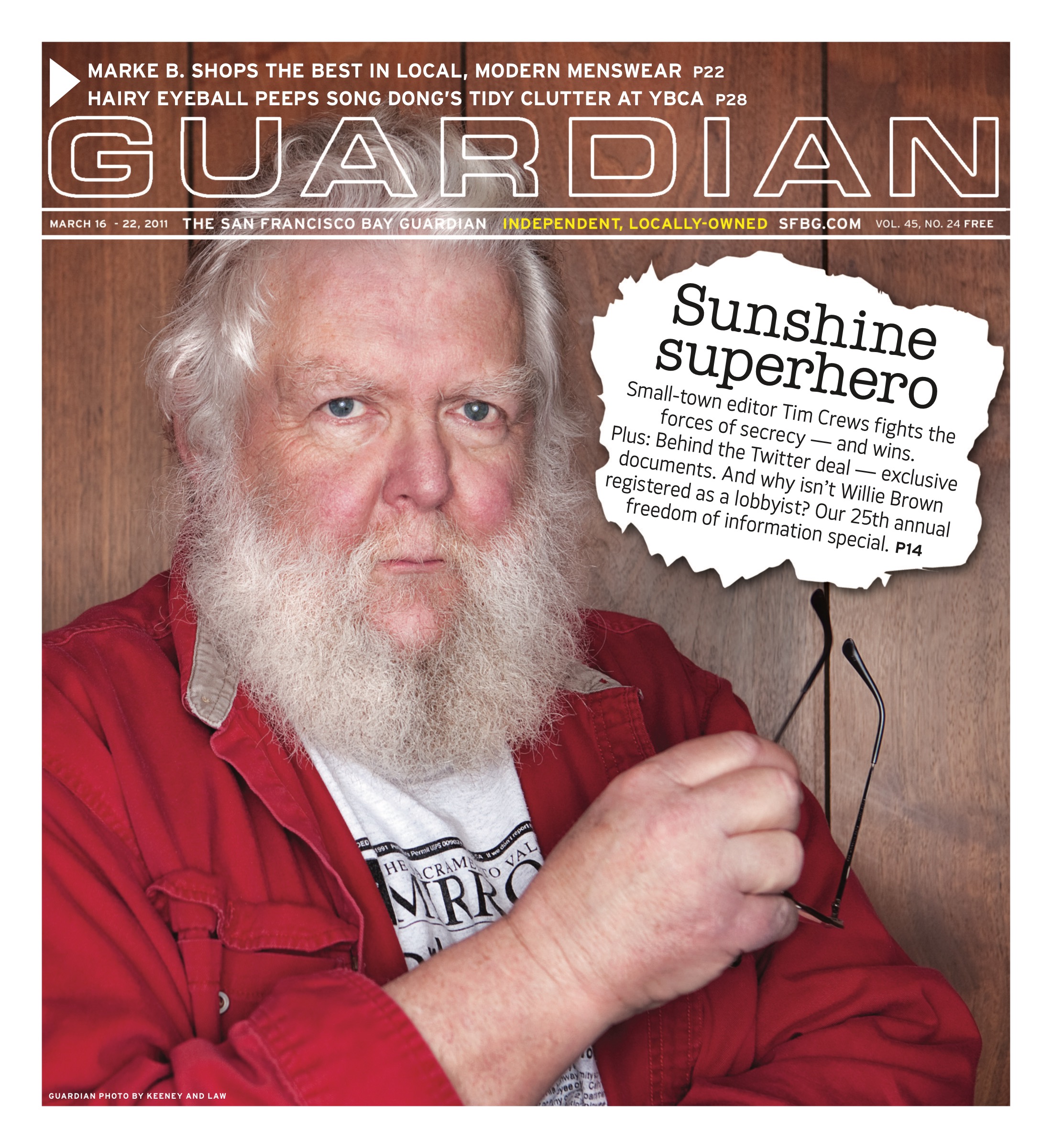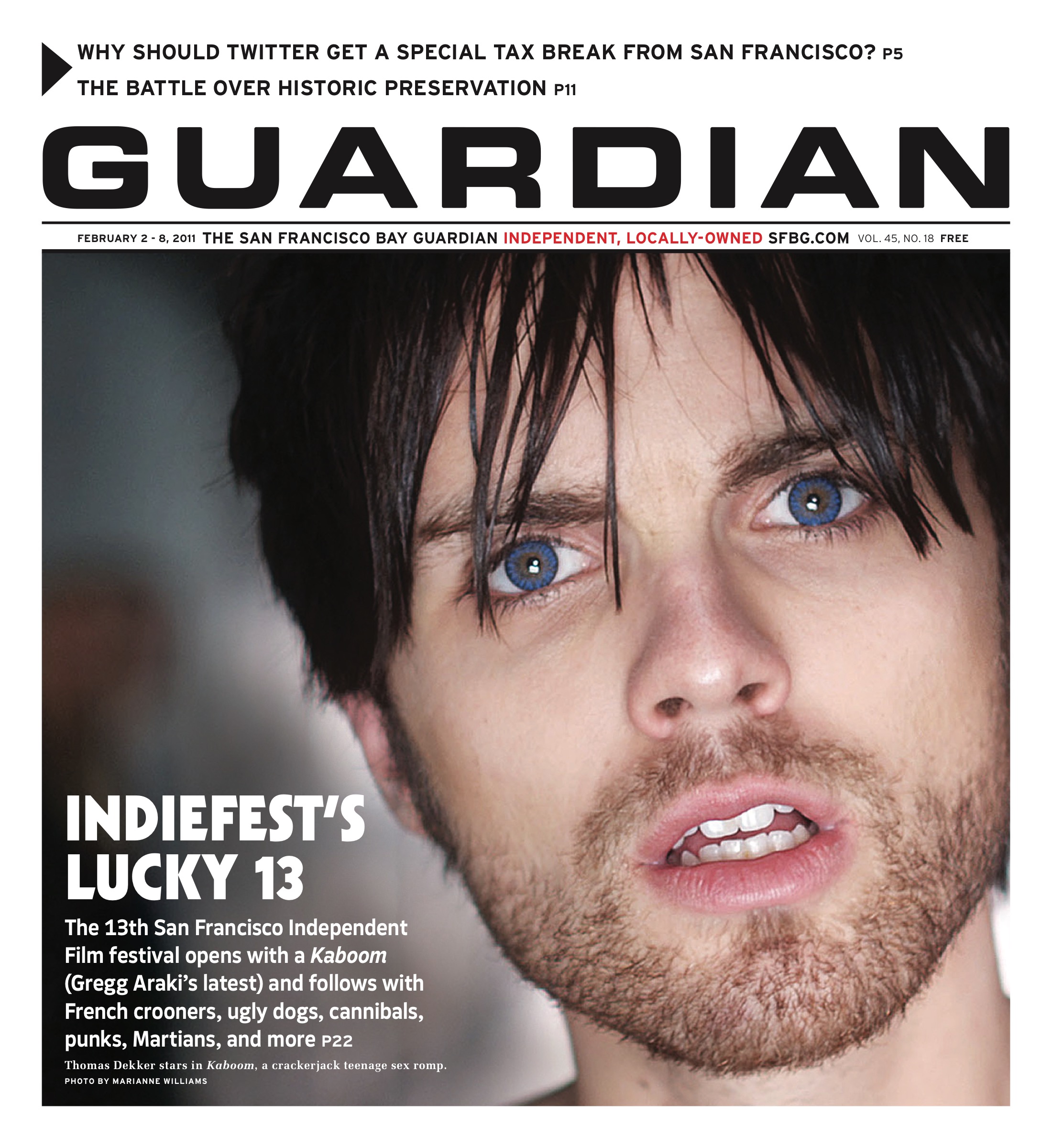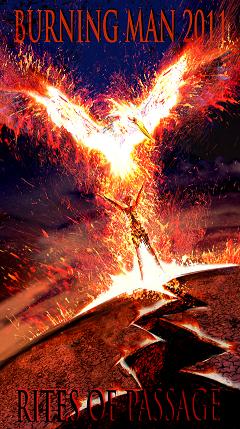superego@sfbg.com
SUPER EGO Dear Miss Rotissary Ethnicity Jackson-Houston Ross,
By the time you read this, I will be gone. Europe and North Africa are calling Hunky Beau and me, and after almost seven years of covering San Francisco nightlife for the Guardian, and 14 years in general, she needs a little break (as does her skin!) Don’t fret, I’ll be back soon enough, in some form, possibly this one, quidnuncking up in your after-dark business. And we’ll be polishing the nightlife part of our weekly Guardian music listings, so you can keep an eye on what all the other queens are up to while I’m gone. Or just know where to go for fun dancing, duh.
Miss Ross, I leave the San Francisco scene in the creatively manicured yet still slightly crackly hands of yourself and all the other gorgeous new club terrors who’ve recently sprouted like neon alfalfa along the gilt gutters of our dance floors. (Although I haven’t seen your name around in a hot minute and sincerely hope you’re not dead.) Our local, organic, small-batch, sustainable, house-manufactured alternative party scene is the sexiest and deepest and most creative in the world right now. Don’t fuck it up, loves. If I come back and it’s all loathsome Britney tribute night$ and DJs/models from Vegas with two “Z”s and a hash tag in their name, I will pull out my hardcore OG Detroit techno wig — the one that’s really three wigs at once, powered by an ECS RS485M-M motherboard and topped with an abandoned 1930s skyscraper on fire that rotates — and level y’all. To the ground.
But of course before I leave, I have just a few things to say. I hope I’ve helped break down any severely tired genre and crowd divisions in the clubs, and I’ve tried my best to elevate nightlife commentary to a higher level than mere celebrity rubbernecking and overuse of the word “fabulous.” Nightlife is an art form, Miss Ross, and it has actually saved my life on several occasions. It has a history, and deserves respect and study. But not so much that it ceases being cuckoo bonkers coco puffs Loleatta Holloway amazing.
Finally, unlike some other outlets in this town, the Guardian’s party coverage has never been for sale. I may over-gush on occasion, and I’ll never actively deflect a dishy bartender’s kind attentions after I’ve written about a party, but you’ll always find “advertorial” between “shit” and “syphilis” and “circuit party” in my dictionary app. I may not look like an objective journalist when sprawled spread-eagle at Lombard and Broadway at 5 a.m. with a paper sack of emptied-out Cuervo pints in one hand and a fierce knock-off Gabrielecorto Moltedo bag of emptied-out dignity in the other, but welcome to the new media. No matter how much I adore the people involved, I’d never steer you toward a Mongolian stinkbomb for the free drinks and pocket change, K?
And now, at last, here’s a gaggle of awesome upcoming special-event spring parties. Farewell, Miss Ross, for now, and goddess bless you and the children and the children’s children and the host with the guest list scrawled on a crumpled-up cocktail napkin in his other pants so everyone gets in free.
Where’s my lime wedge,
Marke B.
WED., MARCH 30
Salem Oh, hi, witch house? You’ve caused a lot of trouble among the no-labels crowd. But few can deny the gothic-gangsta spookiness of your haunted electronic sound. Michigan’s Salem brings the crunky rap and fractured neo-Orff production, openers Soft Moon and Water Borders will hold the crowd spellbound.
8 p.m.-11 p.m., $12.50 advance. 103 Harriet, SF. www.blasthaus.com
Stay Gold Five-Year Anniversary Five years already? Well, the crowd at this mad monthly queer-jam-centric dance-a-thon doesn’t look a day over three — and has grown so huge that they’re moving from the Make-Out Room to Public Works. With resident DJs Rapid Fire and Pink Lightning and guests Dr. Sleep, Pee Play, and Durt.
10 p.m., $3 before 11 p.m., $5 after. Public Works, 161 Erie, SF. www.publicsf.com
THURS., MARCH 31
Ladies of the House NextAid Benefit All women on decks for a dubby-bubbly event in honor of National Women’s History Month, benefiting NextAid, which helps out African women and youth. Icon, Dulce Vita, tamo, shOOey, and more.
7:30 p.m., $10–$20. Public Works, 161 Erie, SF. www.publicsf.com
FRI., APRIL 1
Kool Keith and DJ Godfather Raunchy-outrageous alien rapper meets Detroit king of booty tech? Plus two rooms full of glitchy bass and Chicago footwork? Pack me another bowl, because it’s all coming true.
9 p.m.-3 a.m., $18 adv, $20. Club Six, 66 Sixth St., SF. www.clubsix1.com
SAT., APRIL 2
Blessed Second Anniversary Deep and lovely house with that fantastically rich Oakland vibe — free monthly Blessed celebrates with Australian native DJ Vincent Kwok, who brings a sunny global soul perspective to the tables.
9 p.m., free. SomaR Bar, 1727 Telegraph, Oakl. Facebook: Blessed 2 Year
Emo Spring Break Hahaha, no sunshine for emos, ever, but plenty of fun and sing-a-long emo jams courtesy of awesome ’90s retro night Debaser. Emo, screamo, and pop-punk gems await your mopey hairdo.
The Knockout, 3223 Mission, SF. www.facebook.com/debaser90s
Mount Kimbie Dominic Maker and Kai Campo, a.k.a. Mount Kimbie, are kings of thoughtful post-dubstep (and brought down Public Works last year). They’ll float heavy at Mezzanine with sultry beat-collagist Shigeto, LA’s Matthew David, DJ Dials, and more.
10 p.m., $15 adv. Mezzanine, 444 Jessie, SF. www.mezzaninesf.com
SUN., APRIL 3
Beats For Japan A massive all-day dance community effort to raise funds for those affected by the recent disaster. DJs Mark Farina, Claude Von Stroke, Miguel Migs, Fred Everything, David Harness, Oliver Desmet, Julius Papp, and New Mondo turn it up and out. Be there.
2 p.m–midnight, 10 suggested donation. Public Works, 161 Erie, SF. www.publicsf.com
THURS., APRIL 7
Big Freedia The omnipotent transgender queen of genius New Orleans genre sissy bounce is going to show you all how to get Azz Everywhere with gin in your system. She played Oakland last year and was seriously on fire. With her smart musical compatriot Rusty Lazer.
9 p.m.–late., check website for price, public Works, 161 erie, Sf. www.publicsf.com
7 Dirty Girls This one looks a clever corker. Curvicious Cabaret is putting on this naughty tribute to comedian George Carlin’s famous “Seven Words You Can Never Say on Television” skit. One hot lass performing a routine for each word equals “filthy, depraved, perverted, disgusting, and completely uncensored burlesque.”
9 p.m., $10. Blue Macaw, 2565 Mission, SF. www.curvisiouscabaret.com
FRI., APRIL 8
Jokers of the Scene The hardcore Torontonian goofballs are so nutty they used to be controversial. Now, they’re just good electro fun, and will pack the shiny-shiny Lights Down Low party even more. With Brenmar and Christian Martin (also damn good).
10 p.m.-late, $10. SOM 2925 16th St., SF. www.som-bar.com
Miss Blow Up USA The exuberant 18+ monthly glitz-electro night is still going strong — and now they need a queen (apparently I’ve been retired). Anyone can enter — and everyone wins with DJs Jeffrey Paradise, Lloydski, Dirty Dave, and more.
10 p.m., $10 21+/$15 18+, DNA Lounge, 375 11th St., SF. www.blowupsf.com
SAT., APRIL 9
Aprilween Yes, yes, every day is Halloween for us freaks — but not every night is a massive costume party at the monthly mashup Bootie party. So here you have it, Aprilween, with DJs Adrian and Mysterious D with guests Faroff and Squrrrl and live mashup band Smashup Derby. Plus crazy costume contest.
9 p.m., $8 before 10, $10 after. DNA Lounge, 375 11th St., SF. www.bootiesf.com
BiBi The off-the-hook hot and charitable queer Middle Eastern party returns with a “sail the seven seas” theme. DJs Cairo brings the ululating beats, bellydancers, yummy drink specials, and, as always, friendly hipshakes and sultry winks.
9 p.m., $10. Club 8, 1151 Folsom, SF. www.bibisf.org
Justin Vivian Bond San Francisco’s drag cabaret pride and joy, now slaying them (and scoring Tony noms) in New York City is releasing a new CD, Dendrophile, and bringing a truckload of talent to the Castro Theatre for a scenester’s dream of a performance.
8 p.m.–11 p.m., $25–$65. Castro Theatre, 429 Castro, SF. www.castrotheatre.com
WED., APRIL 13
DJ Kentaro + Japan benefit I am so delighted that actual vinyl turntables are making a comeback — but one glimpse of this Ninja Tune dude’s mad scratch-collage skillness might send a generation running back to Serrato. Proceeds go to Global Givings Japan Earthquake and Tsunami Relief Fund
9:30 p.m.–late, $10. Public Works, 161 Erie, SF. www.publicsf.com
FRI., APRIL 15
Mary Ann Hobbs BBC Radio’s undisputed queen of fractured beats and intel electronic dance comes back to the Bay — with a fanperson’s wet-dream roster: Joy Orbison, Kode9, Roska, Gonjasufi (yes!), Lorn, Ghosts on Tape, and loads more. Sooo good.
10 p.m.–late, $15 adv. 103 Harriet, SF. www.1015.com
Tensnake After a few false visa-issue starts, the German recombinant house prince brings his funky, fantastic, steamy, sing-a-long creations to Public Works. Coma Cat here we come!
9 p.m.–4 a.m., $10 with Facebook RSVP. Public Works, 161 Erie, SF. Facebook: Tensnake Live!
SAT., APRIL 16
Legowelt Absolutely smoking house with a classic mid-’80s feel from this Dutch “slam jack” artiste at a special installment of the rad Donuts! party. Also check out fellow headliners Miracles Club from Portland for more introspective early house-ish sounds and local spectacle-kinksters Tres Lingerie.
9:30 p.m.–3 a.m., $5 before 10, $10 after. Public Works, 161 Erie, SF. www.publicsf.com
TUES., APRIL 19
Bomba Estereo Brash and sexy Colombian electro-cumbia (and rap) band have burned up dance floors and the YouTubes with hit “Fuego.” New EP Ponte Bomb samples Technotronic’s “Pump Up the Jam” to viral effect.
7:30 p.m., $18. The Independent, 628 Divisadero, SF. www.theindependentsf.com
Magical Properties Tour 3 Wicked, knob-twisted abstract bass and visual blasts from L.A. dandy Daedelus, local mensch Shlohmo, and fab Brainfeeder Tokimonsta. The last two installments we’re seriously banging, smoke up.
10 p.m., $12. SOM, 2925 16th St., SF. www.som-bar.com
THURS., APRIL 21
Lil B Who’s ready to get based? You know you are or wish you were. Super-canny Based God Oakland rapper Lil B is probably reaching out to you right now through his 500 Twitter feeds, but I’m telling you about this gig anyway.
9 p.m., $20 adv. Mezzanine, 444 Jessie, SF. www.mezzaninesf.com
The Tubesteak Connection Seventh Anniversary What started as a humble tribute to the gay bathhouse discos of the past has, er, blossomed into a phenomenon over the past lucky seven — as well as expanding its excellent musical scope, via DJ Bus Station John’s sensitive yet probing ear, to become a “petri dish of the era’s many styles.” You’ll still get hella laid by a mustachioed hottie and dance your keister off.
10 p.m., $5. Aunt Charlie’s Lounge, 133 Turk, SF.
FRI., APRIL 22
Fag Friday Another installment of this wildly successful reunion of one of SF’s best gay house parties. The beats get cunty and the family, young and younger, comes out for this one. Special guest Tedd Patterson brings some NYC shine, and residents David Harness and Juanita More turn the packed floor out.
10 p.m.–4 a.m., $10. Public Works, 161 Erie, SF. www.publicsf.com
PantyRaid and Lowriderz Burning Man sleaze-step superstars return with a mighty rumble and bang to meld crunk and dubstep to an apocalyptic sensibility.
10 p.m.–4 a.m., $15 adv. 103 Harriet, SF. www.1015.com
SAT., APRIL 23
Wicked 20 Years of Disco Glory The actually legendary soundsystem has raved through two decades, deepening the original sound into the purely sublime. Celebrating with a full-moon howl will be the original crew: Garth, Jeno, Markie, and Thomas. And you!
10 p.m.–7 a.m., $20 adv. Mighty, 119 Utah, SF. www.mighty119.com
SAT., APRIL 30
Bender’s Second Annual Toga Party The first time this top bar among top bars held a toga party, it burned down (a week later, but still). That won’t happen this time — the bar is back and double the size — despite the hot-sheets in the crowd. With the Corruptors and the Grannies live.
10 p.m., $7. Bender’s, 806 S. Van Ness, SF. www.bendersbar.com
10 p.m., $10 adv.. Public Works, SF. www.publicsf.com
Mighty Real: Jellybean Benitez The Mighty Real classic house series at Mighty kicked off last month with Frankie Knuckles, and it was breathing room only (and fun!). This time another giant, Jellybean Benitez, joins resident DJ David Harness. Here’s hoping he drops some wild freestyle.
10 p.m., $10 adv.. Mighty, 119 Utah, SF. www.mighty119.com
Surefire Sound Tour Wonderful neo-grime, post-dubstep antics from this crew, bringing young phenom Ramadanman (very, very good), Zed Bias, and our very own Salva to the fore.
10 p.m., $10 adv.. Public Works, SF. www.publicsf.com
SUN., MAY 1
How Weird Street Fair Yay! It’s the first of our major street fairs, which means I can finally run wild and free in my bunny suit, legally. Get stoopid in a good way with tons of DJs, one of the best local vibes of the season, and totally WEIRD entertainment. Theme: “Mythical Realms.” After-parties: galore.
Noon-8 p.m., donation requested. Howard and Second Streets, SF. www.howweird.org
Sunset Boat Party Always a tipsy-tyrvy winner on the high seas annually with those Pacific Sound boys, Solar, Galen, and J. Bird.. Check www.pacificsound.net for details and guests.
THURS., MAY 5
Devotion 10-Year Anniversary Good lord, has it really been that long for this former weekly Sunday night affair? It still sounds as fresh as ever, energetically house-y with a dash of Latin love, and even though founder DJ Ruben Mancias has relocated to NYC, there’s always a heavy local vibe when he plays in town. With special guest David Morales, plus David Harness and Teejay Walton.
9 p.m.–late, $10 adv. Mighty, 119 utah, SF. www.mighty119.com
SAT., MAY 7
Tim Xavier How much do I love monthly international live-set techno bonanza Kontrol at the EndUp? Thiiiiiis much, but a little bigger. May sees the Kontrol kids bringing in this intense Berlin musicmaker on the Clink label, who’ll definitely keep the adrenaline level up.
10 p.m.-6 a.m., $20. EndUp, 401 Sixth St., SF. www.rtheendup.com *
















